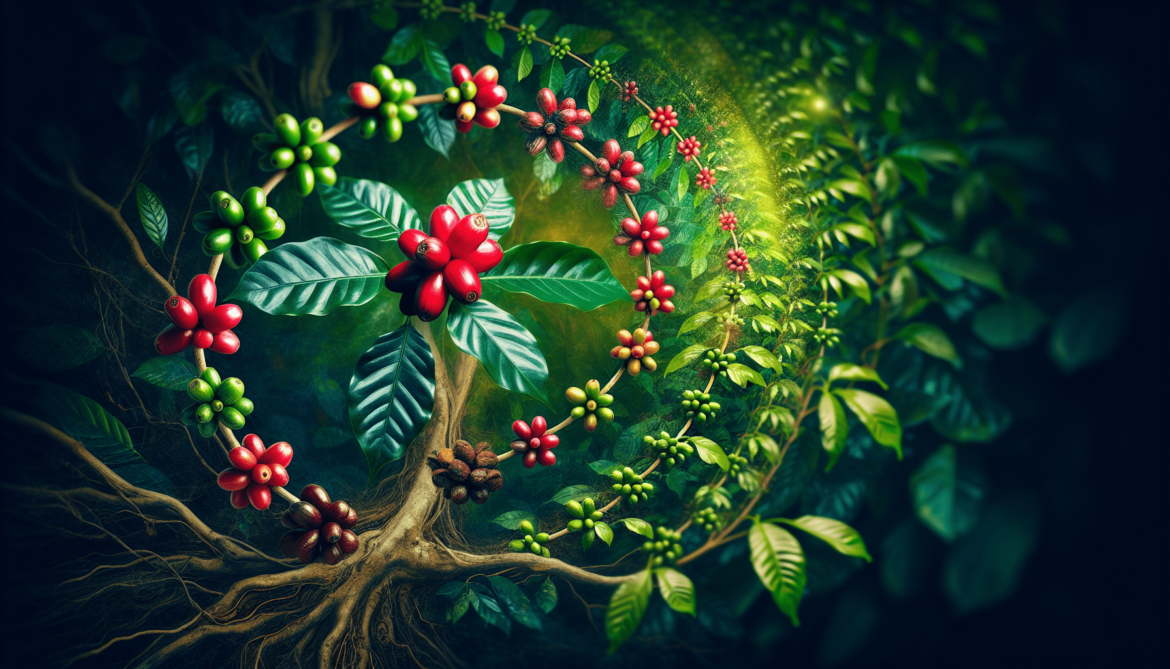Imagine yourself standing beneath the shade of a majestic coffee bean tree, its branches stretching outwards towards the bright blue sky. From the moment a tiny seed is planted in fertile soil, it embarks on an incredible journey – a journey that culminates in the production of one of the world’s most beloved beverages: coffee. This article takes you on a captivating exploration of the journey of a coffee bean tree, from its humble beginnings to the aromatic beans that ultimately find their way into your cup. So grab a cozy seat, and prepare to be amazed by the remarkable story of the coffee bean tree.
Origins of the Coffee Bean Tree
Discovery of Coffee
The journey of a coffee bean begins with the discovery of coffee itself. Legend has it that a goat herder in Ethiopia named Kaldi noticed that his goats became particularly energetic after consuming the cherries from a certain type of tree. Intrigued by this observation, he decided to try the cherries himself, and he too experienced a burst of energy. This led to the realization that these cherries had a stimulating effect, and thus, the discovery of coffee was made.
Historical Origins
The use of coffee as a beverage spread quickly from Ethiopia to the Arabian Peninsula in the 15th century. Arab traders were fascinated by its invigorating properties and carried the magic beans with them on their journeys. Soon, coffee spread throughout the Islamic world, becoming an integral part of the culture, with coffee houses becoming social hubs for intellectual discussions and stimulating conversations.
Cultivation in Ethiopia
Ethiopia, the birthplace of coffee, has a long history intertwined with the coffee bean tree. Coffee cultivation in Ethiopia dates back centuries, and the country is known for its diverse coffee varieties and unique growing conditions. The Ethiopian coffee industry continues to thrive, with many farmers growing coffee beans using traditional, sustainable methods that have been passed down through generations.
Botanical Features
Scientific Classification
The coffee bean tree belongs to the Rubiaceae family and is scientifically known as Coffea. With over 100 species within the Coffea genus, the two most well-known and widely cultivated species are Coffea arabica and Coffea canephora, also known as Robusta. These two species have distinct characteristics that contribute to the different flavors and qualities of their beans.
Coffee Plant Anatomy
The coffee plant is an evergreen shrub that can grow up to 30 feet in height. It has glossy, dark green leaves and produces fragrant white flowers, which eventually develop into coffee cherries. The cherries contain two coffee beans, which are the seeds of the plant. The foliage of the coffee plant provides shade for the coffee cherries and helps to regulate the temperature and moisture levels in the growing environment.
Growth and Lifespan
The coffee plant has a relatively long lifespan, with the potential to produce coffee beans for over 20 years. The growth of the plant begins with germination from a coffee seed. It takes approximately three to four years for a coffee plant to reach maturity and start producing cherries. The growth of the coffee plant is influenced by various factors, including climate, soil conditions, and cultivation practices.
Coffee Bean Varieties
Arabica Beans
Arabica beans are considered the superior variety when it comes to coffee. They are known for their rich aroma, complex flavors, and lower caffeine content compared to Robusta beans. Arabica beans require specific conditions to thrive, such as altitudes between 2,000 to 6,000 feet, cooler temperatures, and ample rainfall. Many coffee enthusiasts appreciate the nuanced flavors and acidity that Arabica beans bring to their cup.
Robusta Beans
Robusta beans, as the name suggests, are known for their robust flavor profile and higher caffeine content. They are generally grown at lower altitudes and are more resistant to diseases and pests compared to Arabica beans. Robusta beans are often used in espresso blends for their ability to provide a strong body and a thick layer of crema. They are also used in instant coffee due to their affordability and availability.
Other Varieties
Beyond Arabica and Robusta, there are several other coffee bean varieties that add diversity to the coffee industry. Some notable varieties include Liberica, Excelsa, and the highly celebrated Geisha (also known as Gesha). These varieties possess unique characteristics and flavors that cater to the diverse preferences of coffee enthusiasts worldwide. Each variety contributes to the rich tapestry of the coffee bean tree’s offerings.
Planting and Cultivation
Ideal Climate and Conditions
Coffee beans thrive in tropical and subtropical regions, where the climate provides the right combination of temperature, rainfall, and sunlight. The ideal temperature range for coffee cultivation is between 60°F and 70°F (15°C and 24°C). Rainfall patterns are crucial, as coffee plants require a well-distributed amount of moisture during different stages of growth. Additionally, coffee plants prefer partial shade to protect them from direct sunlight.
Selecting the Right Soil
Coffee plants have specific soil requirements to ensure optimal growth and yield. They prefer well-draining soil with a pH level between 6 and 6.5. Volcanic soils are often favored, as they are rich in nutrients and provide excellent drainage. It is essential to conduct soil tests and make appropriate amendments to maintain the right balance of organic matter, minerals, and pH levels for healthy coffee plant growth.
Growing from Seeds or Cuttings
Coffee beans can be propagated through either seeds or cuttings. Growing from seeds is the more traditional and time-consuming method. The seeds are carefully selected and planted in specialized nurseries before being transplanted into the field. Cuttings, on the other hand, involve taking a stem from a mature coffee plant and rooting it to create a clone. This asexual reproduction method allows farmers to maintain the characteristics of specific coffee varieties.
Flowering and Fruit Development
Blooming Process
The coffee plant goes through a captivating blooming process before the onset of fruit development. Fragrant clusters of small, white flowers appear on the coffee plant, often covering it in a delicate, sweet-scented blanket. Each flower takes about 48 hours to fully open, providing a short window for pollination. The blooming period is vital, as the successful pollination of flowers determines the formation of cherries and the subsequent yield.
Formation of Berries
After successful pollination, the flowers transform into small, green berries. These berries contain the coffee beans, tightly nestled within a protective layer known as the parchment. The berries grow in clusters and undergo several changes as they progress through the ripening stages. The size, color, and flavor of the berries are influenced by factors such as altitude, climate, and the specific coffee variety.
Ripening Stages
The ripening of coffee berries is a gradual process that evolves from green to vibrant red or yellow, depending on the variety. Coffee cherries reach their optimal ripeness when the sugars inside them have fully developed and the seed has matured. This stage is crucial for harvesting and obtaining the desired flavor profiles. Careful observation and experience are required to identify the ideal timing for harvesting the cherries based on color, taste, and texture.
Coffee Bean Harvesting
Selective Picking
Selective picking involves handpicking individual ripe cherries when they are perfectly mature. This method ensures that only the best quality cherries are harvested, leading to a more refined and nuanced flavor profile. However, selective picking is labor-intensive and time-consuming, as it requires multiple rounds of harvesting to account for the varying ripeness of the cherries within a single tree.
Mechanical Stripping
Mechanical stripping, also known as strip harvesting, involves using machinery to strip the entire coffee tree of its cherries, regardless of their individual ripeness. This method is often employed in large-scale commercial plantations to optimize efficiency and reduce labor costs. However, the resulting coffee beans may lack the quality and flavor complexity associated with selective picking.
Processing the Cherries
After harvesting, the coffee cherries need to undergo processing to transform them into the familiar green coffee beans. There are two primary processing methods: wet processing and dry processing. Wet processing involves removing the pulp and skin from the cherries before drying the beans, while dry processing involves sun-drying the cherries with the pulp intact. The chosen processing method greatly influences the flavor profile of the resulting coffee beans.
Coffee Bean Processing
Wet Processing
Wet processing is the more modern and widespread method of processing coffee beans. The cherries are first pulped to remove the outer skin and fruit pulp, revealing the unroasted coffee beans. Next, the beans undergo fermentation, where they are left in water tanks to remove any remaining mucilage. Once fermented, the beans are washed, dried, and further processed to remove the parchment layer, resulting in green coffee beans ready for roasting.
Dry Processing
Dry processing, also known as the natural process, is the more traditional method of processing coffee beans. In this method, the whole cherries, complete with the pulp, are spread out on raised beds or patios to dry naturally under the sun. This extended drying period allows the sugars from the pulp to infuse into the beans, giving them a distinctive fruity and wine-like flavor. Once fully dried, the cherries are mechanically hulled, and the green coffee beans are extracted.
Milling and Sorting
After the coffee beans have been processed, they go through the milling and sorting stage. This involves removing any remaining impurities, defects, and foreign matter from the beans. The beans are sorted based on their size, shape, color, and density to ensure uniformity and consistency. This meticulous process guarantees that only the highest-quality beans make their way to the next step: roasting.
Roasting the Coffee Beans
Chemical Changes
Roasting is the transformative process that turns raw, green coffee beans into the aromatic, flavorful beans we are familiar with. During roasting, the beans undergo a series of chemical changes. First, the moisture within the beans evaporates, followed by the breakdown of starches into sugars. As the temperature increases, the sugars caramelize, creating new flavors and aromas. Finally, the beans undergo the Maillard reaction, resulting in the development of rich, complex flavors.
Roast Levels
There are different roast levels that influence the final flavor profile of the coffee beans. Light roasts are typically more acidic and have a light body, allowing the unique characteristics of the coffee bean variety to shine. Medium roasts strike a balance between acidity and richness, offering a more well-rounded flavor profile. Dark roasts, on the other hand, have a robust, smoky flavor and a fuller body, with the original characteristics of the beans often giving way to bold, caramelized notes.
Art and Science of Roasting
Roasting coffee beans is both an art and a science. Roasters carefully fine-tune the time, temperature, and airflow to bring out the optimal flavors from each bean variety. They rely on their palate and experience to make precise adjustments throughout the roasting process. The goal is to unlock the desired flavor notes while preserving the inherent qualities that make each batch of coffee unique. Roasting truly showcases the craftsmanship and expertise of coffee artisans.
Grinding and Brewing
Grinding Methods
Grinding coffee beans just before brewing is key to unlocking the full potential of their flavor. There are various grinding methods available, ranging from manual hand grinders to electric burr grinders. The coarseness of the grind depends on the brewing method used. For espresso, a fine grind is necessary to achieve the right extraction, while a coarser grind is suitable for methods such as drip brewing or French press.
Coffee Brewing Techniques
Coffee enthusiasts have an array of brewing techniques to choose from, each offering a slightly different taste experience. Some popular brewing methods include pour-over, French press, espresso, Aeropress, and cold brew. Each method utilizes specific equipment and brewing parameters to extract the desired flavors and characteristics of the coffee beans. The choice of brewing technique allows for customization and exploration of the nuances within each batch of brewed coffee.
Popular Brewing Equipment
Brewing equipment comes in different shapes and sizes, designed to cater to the preferences and lifestyles of coffee lovers. From classic drip coffee makers to sleek espresso machines, the options are vast. Other popular brewing tools include pour-over drippers, French presses, AeroPress devices, and single-serve pod systems. With advancements in technology and a growing interest in specialty coffee, coffee lovers can immerse themselves in a world of brewing possibilities.
The Journey to Your Cup
Coffee Distribution and Supply Chain
Once the coffee beans have been roasted and packaged, they embark on a journey through the distribution and supply chain. Coffee is traded globally, with numerous players involved in sourcing, importing, roasting, packaging, and distributing the beans to coffee shops, retailers, and consumers. The supply chain ensures that coffee lovers around the world can enjoy a cup of their favorite brew, connecting the efforts of farmers, processors, roasters, and baristas across continents.
Packaging and Storage
Packaging plays a crucial role in preserving the freshness and quality of coffee beans. Roasted coffee is typically packaged in airtight containers or bags with one-way valves to release the gases released by the freshly roasted beans while keeping external oxygen out. This helps to prolong the shelf life of the beans and maintain their flavors and aromas. Proper storage in a cool, dry place away from direct sunlight is also essential to preserve the coffee’s quality over time.
Preparing the Perfect Cup
Preparing the perfect cup of coffee is an art in itself, requiring attention to detail and an understanding of brewing techniques. It starts with choosing high-quality, freshly roasted beans and grinding them just before brewing. The right water temperature, brew time, and extraction ratio all contribute to the final flavor profile. Whether you prefer a rich and velvety espresso or a smooth, well-balanced pour-over, finding the perfect balance of flavors is an exciting journey that awaits every coffee lover.
In conclusion, the journey of a coffee bean tree is truly remarkable. From its ancient origins in Ethiopia to the thriving global coffee industry today, the coffee bean has captivated people’s hearts and taste buds for centuries. Understanding the botanical features, cultivation methods, and processing techniques that shape the coffee we know and love adds depth and appreciation to every cup. So, the next time you savor your morning brew, take a moment to reflect on the incredible journey that brought that humble coffee bean from a tree thousands of miles away to your cup.



